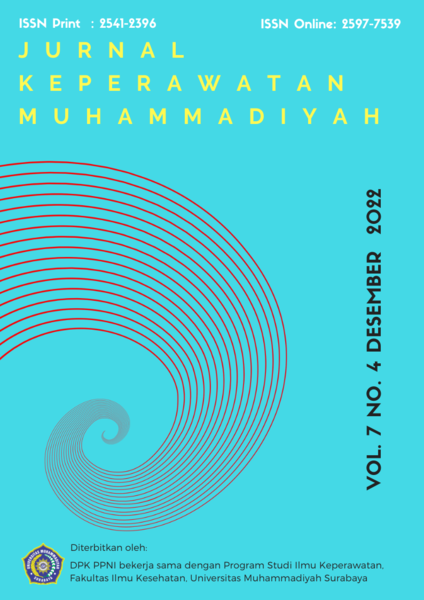Pengaruh Edukasi Kesehatan Fisik Tentang COVID-19 Terhadap Kemampuan Menerapkan AKB Pada Siswa SD
DOI:
https://doi.org/10.30651/jkm.v7i4.15763Abstrak
Objective: Covid-19 pandemic is a non-natural disaster. Everyone, including children, becomes stressed, to prevent transmission of the virus, an adaptation of new habits is needed, so it is necessary to provide knowledge in the form of repeated education related to new normal adaptation to improve physical health. This is necessary so that the child's ability to apply the new normal adaptation is consistent. This new normal adaptation is a necessary step to determine the readiness of elementary school children to conduct limited face-to-face learning
Methods: Â This article used a pre-experimental design, namely by means of a one-group pre-test-post-test design for 73 elementary school students in Bandung. The child is given a pre-test regarding the new normal adaptation and then a video is given about physical health that must be considered in the new normal adaptation, after which a post-test assessment is carried out. Bivariate Analysis Using the Wilcoxon test. Â
Results: The results of the study found that there was an influence before being given physical health education about covid-19 on the ability of elementary school students to implement the new normal adaptation.
Conclusion: Â Researchers suggest parents and teachers to keep reminding their children to adapt to new habits.Referensi
Bintang Agustina; dan Oktarianita. (2021). Pengaruh edukasi protocol kesehatan menggunakan media video terhadap pengetahuan anak panti. Jurnal Kesehatan Masyarakat Khatulistiwa. Vol 8, N0.4, Desember 2021, hal 205-212.
Balasubramanian, S., Rao, N. M., Goenka, A., Roderick, M., & Ramanan, A. V.(2020). Coronavirus Disease 2019 (COVID-19) in Children - What We Know So Far and What We Do Not. Indianpediatrics,57(5),435–442.https://doi.org/10.1007/s13312-020-1819-5
Bailey, R., & Scheuer, C. (2022). The COVID-19 pandemic as a fortuitous disruptor in physical education: the case of active homework. AIMS public health, 9(2), 423–439. https://doi.org/10.3934/publichealth.2022029
Bialek S,BoundyE,BowenV,etal.Severe outcomes among pa-tients with coronavirus disease 2019 (COVID-19) — United States, February 12–March16, 2020. MMWR Morb Mortal WklyRep. 2020;69:343-346.
Birch, D. A., & Auld, M. E. (2019). Public Health and School Health Education: Aligning Forces for Change. Health promotion practice, 20(6), 818–823. https://doi.org/10.1177/1524839919870184
Chambonniere, C., Lambert, C., Fearnbach, N., Tardieu, M., Fillon, A., Genin, P., Larras, B., Melsens, P., Bois, J., Pereira, B., Tremblay, A., Thivel, D., & Duclos, M. (2021). Effect of the COVID-19 lockdown on physical activity and sedentary behaviors in French children and adolescents: New results from the ONAPS national survey. European journal of integrative medicine, 43, 101308. https://doi.org/10.1016/j.eujim.2021.101308
Cheng KK, Lam TH, Leung CC. Wearing face masks in the community during the COVID-19 pandemic: altruism and solidarity. Lancet. 2020; 2019 (20):2019–20
DongY,MoX,HuY,QiX,JiangF,JiangZ,&....(2020). Epidemiological characteristics of 2143 pediatric patients with 2019 corona virus disease in China. Pediatrics. 2020 Mar. Availablefrom:https://pediatrics.aappublications.org/content/pediatrics/early/2020/03/16/peds.2020-0702.1.full-text.pdf. AccessedonApril04,2020. [Epubaheadofprint]
Ghate,S., Parekh,B.J., Thapar,R.K., Nadkarni,P.R.,Sen,S.,Bansal,U.,Sambhariya, C. H., Popat, S., Bhattacharya, P.,Kirtani, S., Kanetkar,Y.,Vats, S. P., Kamath, S. S., Raj, M., Basavaraja, G. V., & Gupta, P. (2020). Indian Academy of Pediatrics Guidelines on School Reopening, Remote Learning and Curriculum in and After the COVID-19 Pandemic. Indian pediatrics, 57(12),1153–1165. https://doi.org/10.1007/s13312-020-2072-7
Garvey, W., Schembri, R., Oberklaid, F., & Hiscock, H. (2022). A health-education intervention to improve outcomes for children with emotional and behavioural difficulties: protocol for a pilot cluster randomised controlled trial. BMJ open, 12(6), e060440. https://doi.org/10.1136/bmjopen-2021-060440
Jiao, W.Y., Wang, L.N., Liu, J., Fang, S.F., Jiao, F.Y., Pettoello-Mantovani, M.,Somekh, E (2020). Behavioral and emotional disorders in children during the COVID-19 epidemic. J. Pediatr., S0022-3476(20)30336X. https://doi.org/10.1016/j.jpeds.2020.03.013. PubMed.
Lee, J.(2020). Mental health effects of school closures during COVID-19. Lancet.Child Adolesc. Health, S2352-4642(20)30109-7.https://doi.org/10.1016/S2352-4642(20)30109-7. PubMed.
LivingstonE, BucherK. Corona virus disease 2019 (COVID-19) in Italy. JAMA. 2020.
Lotfi, M., Hamblin, M.R., & Rezaei, N.(2020).COVID-19: Transmission, prevention, and potential. Clinic achimicaacta; international journal of clinical chemistry, 508,254–266. https://doi.org/10.1016/j.cca.2020.05.044
Sumartyawati, N. M., Santosa, I. M. E., & ... (2020). PromosiDukungan Kesehatan Jiwa dan Psikososial Pada Masyarakat di Wilayah Propinsi Nusa Tenggara Barat. … Masyarakat …, 01(03), 90–96. https://doi.org/10.33221/jpmim.v1i03.849
Sprawls., P. (2008). Evolving models for medical physics education and training: A global perspective. Biomedical Imaging and Intervention Journal (biij). http://www.biij.org/2008/1/e16. Doi: 10.2349/biij.4.1.e16
Taeymans, J., Luijckx, E., Rogan, S., Haas, K., & Baur, H. (2021). Physical Activity, Nutritional Habits, and Sleeping Behavior in Students and Employees of a Swiss University During the COVID-19 Lockdown Period: Questionnaire Survey Study. JMIR public health and surveillance, 7(4), e26330. https://doi.org/10.2196/26330
UNICEF. (2019). Global population of children 2100. Statista. https://www.statista.com/statistics/678737/total-number-of-children-worldwide/.
World Health Organization/ WHO. (2020). WHO Director-General's opening remarks atthemedi a briefing on COVID-19-11 March 2020 2020 March 11 [Available from: https://www.who.int/dg/speeches/detail/who-director-general-s-opening-remarks-at-the-media-briefing-on-covid-19—11-march-2020
Zhang Y. (2020). The Epidemiological Characteristics of an Outbreak of 2019 Novel Corona virus Diseases (COVID-19)—China, 2020. Chinese Journal of Epidemiology (by The Novel Corona virus Pneumonia Emergency Response Epidemiology Team). 2020
Unduhan
Diterbitkan
Terbitan
Bagian
Lisensi
- Penulis tetap memegang hak atas karyanya dan memberikan hak publikasi pertama kepada jurnal ini yang secara simultan karya tersebut dilisensikan di bawah:Â Creative Commons Attribution-ShareAlike 4.0 International (CC BY-SA 4.0)













